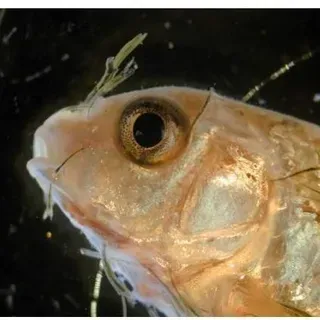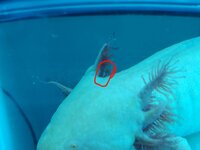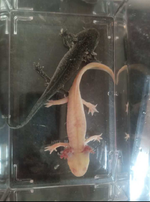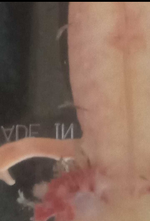Elder_Axolotl
New member
Hello everybody, Im new to this forum,
I have been an Axolotl owner for about 10 months now, and I have noticed one main thing about keeping Axolotls.
That would be when an odd illness or something concerning strikes, you can forget about getting straight forward advice because everyone does everything a bit different.
Not to mention If you don't do it that specific way you're wrong, I look at it like this: There's more than one way to fall a tree.
My Golden Albino type has recently gotten a rare but dangerous illness: Anchor Worms, Lernaea Cyprinacea.
I'd like to share my experience on this ongoing illness because these past days have been a roller coaster of unknown.
There are so few documented cases of this in Axolotls, that a google search yields about 4 results to forums that have maybe 2 or 3 snotty replies from people who barely help or scream for salt baths or fridging.
So enough ranting, and if you're reading this because your 'lotl has anchor worms: CONSULT AN EXOTIC PET VET!! at least by phone, to get a plan of attack, and if an emergency arises you have a rapport built already.
Lernaea, or anchor worms, are not a worm but a crustacean more closely related to a crab or shrimp.
You can read about their life cycle HERE.
Since these are on Axolotls we are VERY limited on treatments, which is why I said you need to consult an exotic pets vet earlier.
The problem isn't so much the juvenile worms it's the eggs and the adult females. The females are the only ones that become parasitic after mating to produce eggs,
they will continue to produce for up to 16 weeks, laying around 200-250 eggs every two weeks though that period.
The adult females and the eggs are very resistant to many treatments, like salt baths. The bath will kill juveniles, but eggs or adult females have a high survival rate in salinity higher than an axolotl can withstand.
If you have an infestation, you will NEED to put your axie in a treatment/quarantine tank because this breaks the life cycle of the parasite, or you can Tub it with daily 100% water changes. It might be in your best interest to sterilize your main enclosure with a 10% bleach solution, because these eggs are HARDY. I will include my sterilization procedure below, however, as a forewarning: You will lose your cycle but there are many published ways that you can use to get it back rather quickly. I'm using an empty tank method with starting culture or "inoculum" and household ammonium hydroxide.
I spoke with my local exotic pet vet and confirmed with him over the phone I indeed have anchor worm, and he has ordered me some Dimilin which is an Organophosphate Insecticide that is very potent.
however he said it wont kill the adults unless they are molting during treatment. We are going to do the treatment first, he will give me more specific instruction for dosing once I go to pick up the meds. And then after the treatment I will take my axie to him to be sedated and have the adults removed. He wants to treat before and after to make sure that no juveniles have a chance to attach after treatment.
I have two axolotls, Skittles, Female Golden Albino GFP. and Toothless, Female Black Melanoid Leucistic GFP.
Skittles is the only one presenting with the worms, however they share an enclosure so both will receive treatment. Each has been placed into a quarantine tank that was previously sterilized before the transfer using this procedure:
My setup is a 36 gallon bowed front aquarium, with an internal sponge filter, and a Marineland 220 external canister filter with spray bar.
1. Remove all decor and place into buckets, this includes the substrate, external filter hoses, clamps, and suction cups, but does not include filter media, I have very fine smooth sand substrate. remove all media from your filter and set aside.
2. After the decor and substrate are in the buckets (mine were 5 gallon buckets from home depot) use a 9:1 ratio of water and bleach. Each bucket received a 1/2 gallon dose of bleach and filled with water leaving enough room to move without spilling. I placed my empty canister filter in the bathtub and filled with bleach solution placed the pump head on, and the inlet and outlet tube in one of the decor buckets and plugged it in to clean and sanitize the pump head as well.
3. let these soak for at least 10 minutes, and use this time to fill a 1000 ml spray bottle with a 10% bleach solution, 900 ml water to 10 ml bleach.
4. Spray all internal surfaces of tank and let sit for 10 minutes.
5. I rinsed all my decor and substrate in regular tap water at least twice, to rid most of the bleach.
6. THIS STEP CAN BE DANGEROUS I made sure to thoroughly rinse ALL surfaces of bleach before performing this step as it requires using vinegar to neutralize the bleach residue. Vinegar reacts with bleach to create Chlorine Gas which is toxic to pets and humans, it is heavier than air and can fill the bottom of a room displacing air which would cause suffocation. Please be sure to rinse your decor and provide adequate ventilation and keep the chemicals separated, and away from each other.
Fill your buckets with a 10% vinegar solution then soak and rinse with tap water untill no bleach or vinegar smell remains and allow to air dry.
7. wipe inside of tank down with clean cloth or paper towels until no bleach solution remains.
8. Fill a spray bottle with a 10% vinegar solution and spray all internal surfaces of tank down let stand 5 minutes and wipe with clean cloth or paper towels, then let air dry.
re rinse
9. Since I have a canister filter I removed the media from the baskets seperated and placed each individual type of media into a seperate bowl.
10. Bring a large pot of water to a rolling boil.
11. place each media into the boiling water for 10 minutes each, yes I even boiled my foam media and plastic Bio Balls. Remove and let cool.
I did each basket of media separately so I didn't have to sort my different bio medias.
12. I soaked each media basket in a hydrogen peroxide bath for 5 minutes and rinsed under hot tap water and let everything air dry.
If you have a HOB filter, follow what I did form my canister filters canister and pump head, however your filter likely takes a cartridge so just replace it and boil any bio foam or bio media you have to sterilize it.
To aid in cycling my tank I do this, you don't have to but i've just found this works well. However, you do need a freshwater master test kit for this:
1. Place all substrate and decor back into tank and hook filters and such up as if you just perforemd a regular maintainance, just dont put anything living back in.
2. Fill tank with 86 degree F treated tap water, and get your filter(s) and air pump(s) running. even though i have an axie tank, I keep a 200 w heater for cycling.
If you can keep your water at 86-89 deg F your cycle will take much faster. I call it my incubation heater. It is never in the tank when I add my axies. and the water remains at 60 - 63 while my axolotl's are in the tank.
3. Dump in your measured amount of inoculum, I personally use API Quick Start at 2 times dose for the initial and then 1/2 dose every day until my nitrites start showing usually about 2-5 days.
4. Take a SMALL dropper and place 4-5 drops per 10 gal of water of household Ammonium Hydroxide and let it circulate for 5 minutes.
5. After the 5 minutes use a test kit to test the ammonia concentration. You want it to be about 2.0 ppm but not higher than 4.0 ppm.
6. Wait 24 hours and retest this time also testing for nitrites and nitrates.
7. I had a concentration of .25 ppm nitrites after 24 hours 0 nitrates and still about 1.5 ppm ammonia. Place about 2-3 drops of ammonium hydroxide into the tank, to keep the level at about 2.0 ppm, and wait another 24 hours.
8. Continue this cycle of testing and adding ammonia until you have Nitrates, this can take anywhere from one to three weeks.
9. Once you have nitrates stop adding the ammonium hydroxide, and test daily until ammonia and Nitrites appear at 0 ppm, usually about 4-5 days.
10. Perform a 90 - 95% water change and you are ready to add your aquatic pets back into the tank.
Usually this process takes about 45 days but it can happen faster if you use the heater. Sure beats the 3 months my tank took to cycle after I bought it.
I will continue to post updates and will get some pictures of the worms for help identifying.
I have been an Axolotl owner for about 10 months now, and I have noticed one main thing about keeping Axolotls.
That would be when an odd illness or something concerning strikes, you can forget about getting straight forward advice because everyone does everything a bit different.
Not to mention If you don't do it that specific way you're wrong, I look at it like this: There's more than one way to fall a tree.
My Golden Albino type has recently gotten a rare but dangerous illness: Anchor Worms, Lernaea Cyprinacea.
I'd like to share my experience on this ongoing illness because these past days have been a roller coaster of unknown.
There are so few documented cases of this in Axolotls, that a google search yields about 4 results to forums that have maybe 2 or 3 snotty replies from people who barely help or scream for salt baths or fridging.
So enough ranting, and if you're reading this because your 'lotl has anchor worms: CONSULT AN EXOTIC PET VET!! at least by phone, to get a plan of attack, and if an emergency arises you have a rapport built already.
Lernaea, or anchor worms, are not a worm but a crustacean more closely related to a crab or shrimp.
You can read about their life cycle HERE.
Since these are on Axolotls we are VERY limited on treatments, which is why I said you need to consult an exotic pets vet earlier.
The problem isn't so much the juvenile worms it's the eggs and the adult females. The females are the only ones that become parasitic after mating to produce eggs,
they will continue to produce for up to 16 weeks, laying around 200-250 eggs every two weeks though that period.
The adult females and the eggs are very resistant to many treatments, like salt baths. The bath will kill juveniles, but eggs or adult females have a high survival rate in salinity higher than an axolotl can withstand.
If you have an infestation, you will NEED to put your axie in a treatment/quarantine tank because this breaks the life cycle of the parasite, or you can Tub it with daily 100% water changes. It might be in your best interest to sterilize your main enclosure with a 10% bleach solution, because these eggs are HARDY. I will include my sterilization procedure below, however, as a forewarning: You will lose your cycle but there are many published ways that you can use to get it back rather quickly. I'm using an empty tank method with starting culture or "inoculum" and household ammonium hydroxide.
I spoke with my local exotic pet vet and confirmed with him over the phone I indeed have anchor worm, and he has ordered me some Dimilin which is an Organophosphate Insecticide that is very potent.
however he said it wont kill the adults unless they are molting during treatment. We are going to do the treatment first, he will give me more specific instruction for dosing once I go to pick up the meds. And then after the treatment I will take my axie to him to be sedated and have the adults removed. He wants to treat before and after to make sure that no juveniles have a chance to attach after treatment.
I have two axolotls, Skittles, Female Golden Albino GFP. and Toothless, Female Black Melanoid Leucistic GFP.
Skittles is the only one presenting with the worms, however they share an enclosure so both will receive treatment. Each has been placed into a quarantine tank that was previously sterilized before the transfer using this procedure:
My setup is a 36 gallon bowed front aquarium, with an internal sponge filter, and a Marineland 220 external canister filter with spray bar.
1. Remove all decor and place into buckets, this includes the substrate, external filter hoses, clamps, and suction cups, but does not include filter media, I have very fine smooth sand substrate. remove all media from your filter and set aside.
2. After the decor and substrate are in the buckets (mine were 5 gallon buckets from home depot) use a 9:1 ratio of water and bleach. Each bucket received a 1/2 gallon dose of bleach and filled with water leaving enough room to move without spilling. I placed my empty canister filter in the bathtub and filled with bleach solution placed the pump head on, and the inlet and outlet tube in one of the decor buckets and plugged it in to clean and sanitize the pump head as well.
3. let these soak for at least 10 minutes, and use this time to fill a 1000 ml spray bottle with a 10% bleach solution, 900 ml water to 10 ml bleach.
4. Spray all internal surfaces of tank and let sit for 10 minutes.
5. I rinsed all my decor and substrate in regular tap water at least twice, to rid most of the bleach.
6. THIS STEP CAN BE DANGEROUS I made sure to thoroughly rinse ALL surfaces of bleach before performing this step as it requires using vinegar to neutralize the bleach residue. Vinegar reacts with bleach to create Chlorine Gas which is toxic to pets and humans, it is heavier than air and can fill the bottom of a room displacing air which would cause suffocation. Please be sure to rinse your decor and provide adequate ventilation and keep the chemicals separated, and away from each other.
Fill your buckets with a 10% vinegar solution then soak and rinse with tap water untill no bleach or vinegar smell remains and allow to air dry.
7. wipe inside of tank down with clean cloth or paper towels until no bleach solution remains.
8. Fill a spray bottle with a 10% vinegar solution and spray all internal surfaces of tank down let stand 5 minutes and wipe with clean cloth or paper towels, then let air dry.
re rinse
9. Since I have a canister filter I removed the media from the baskets seperated and placed each individual type of media into a seperate bowl.
10. Bring a large pot of water to a rolling boil.
11. place each media into the boiling water for 10 minutes each, yes I even boiled my foam media and plastic Bio Balls. Remove and let cool.
I did each basket of media separately so I didn't have to sort my different bio medias.
12. I soaked each media basket in a hydrogen peroxide bath for 5 minutes and rinsed under hot tap water and let everything air dry.
If you have a HOB filter, follow what I did form my canister filters canister and pump head, however your filter likely takes a cartridge so just replace it and boil any bio foam or bio media you have to sterilize it.
To aid in cycling my tank I do this, you don't have to but i've just found this works well. However, you do need a freshwater master test kit for this:
1. Place all substrate and decor back into tank and hook filters and such up as if you just perforemd a regular maintainance, just dont put anything living back in.
2. Fill tank with 86 degree F treated tap water, and get your filter(s) and air pump(s) running. even though i have an axie tank, I keep a 200 w heater for cycling.
If you can keep your water at 86-89 deg F your cycle will take much faster. I call it my incubation heater. It is never in the tank when I add my axies. and the water remains at 60 - 63 while my axolotl's are in the tank.
3. Dump in your measured amount of inoculum, I personally use API Quick Start at 2 times dose for the initial and then 1/2 dose every day until my nitrites start showing usually about 2-5 days.
4. Take a SMALL dropper and place 4-5 drops per 10 gal of water of household Ammonium Hydroxide and let it circulate for 5 minutes.
5. After the 5 minutes use a test kit to test the ammonia concentration. You want it to be about 2.0 ppm but not higher than 4.0 ppm.
6. Wait 24 hours and retest this time also testing for nitrites and nitrates.
7. I had a concentration of .25 ppm nitrites after 24 hours 0 nitrates and still about 1.5 ppm ammonia. Place about 2-3 drops of ammonium hydroxide into the tank, to keep the level at about 2.0 ppm, and wait another 24 hours.
8. Continue this cycle of testing and adding ammonia until you have Nitrates, this can take anywhere from one to three weeks.
9. Once you have nitrates stop adding the ammonium hydroxide, and test daily until ammonia and Nitrites appear at 0 ppm, usually about 4-5 days.
10. Perform a 90 - 95% water change and you are ready to add your aquatic pets back into the tank.
Usually this process takes about 45 days but it can happen faster if you use the heater. Sure beats the 3 months my tank took to cycle after I bought it.
I will continue to post updates and will get some pictures of the worms for help identifying.




